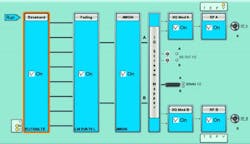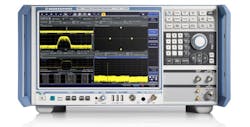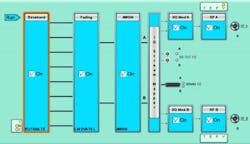Signal Generator Simplifies Complex MIMO Tests
The evolution of wireless standards is posing new challenges for RF test instruments. Bandwidths are increasing, with the IEEE 802.11ac wireless local area networking (WLAN) standard, for example, specifying bandwidths as wide as 160 MHz in the 5-GHz transmission range. The multitude of available wireless standards also requires more interference simulation. In addition, multi-standard radios—including components designed for wideband operation—are needed in today’s mobile base stations. In new standards, the use of multiple-input multiple-output (MIMO) techniques in increasingly higher orders also is resulting in ever-more complicated test scenarios.
To meet these challenges, Rohde & Schwarz has launched a new vector signal generator (VSG). It combines a baseband generator, RF generator, and fading simulator in a single instrument known as the SMW200A (Fig. 1). The instrument’s frequency range is 100 kHz to 3 GHz or 6 GHz. It supports all of the important communications standards (LTE-A, TD-LTE, FDD-LTE, UMTS, IEEE 802.11ac, and more). Because it can be built in, there is no need to connect to a PC. Two hardware baseband modules offer a maximum of eight baseband generators.
1. This vector signal generator covers frequencies to 6 GHz and includes support for all of the major wireless standards, with particular emphasis on MIMO.
Complex signal scenarios like TD-LTE (8x2 MIMO) and LTE-A carrier aggregation (2x2 MIMO) require two RF sources. As a result, the SMW200A has the option to include a second RF path. As many as four internal fading simulator modules, using the latest compact field-programmable-gate-array (FPGA) technology, help to create realistic signal simulations. The SMW200A can emulate as many as 16 fading channels with bandwidths as wide as 160 MHz.
Time resolution of 2.5 ps—combined with the capability to simulate as many as 20 paths per fading channel—enable accurate simulation of indoor reflections. Such reflections have a time delay of only a few nanoseconds between echoes. Fading presets include Raleigh, Rice, or pure Doppler, as well as birth-death, moving propagation, and high-speed train effects.
Previously, multiple instruments would have been required to simulate TD-LTE or LTE-A carrier aggregation with fading of this quality. The SMW200A therefore saves space and weight while eliminating a large amount of cabling. More than two RF sources are required for 3x3 MIMO (for WLAN) or 4x4 MIMO (for FDD-LTE). In these cases, external in-phase/quadrature (I/Q) modulated RF signal generators (part number SGS100A) can be connected and directly controlled by the SMW200A. Multi-standard setups, such as 2x2 MIMO for LTE and 3GPP FDD HSPA, also are possible.
Setting up all of these complex scenarios may seem like a headache at first glance. Yet the SMW200A boasts a large touchscreen interface, which displays simple-to-understand block diagrams to visualize the signal flow (Fig. 2). Blocks can be dragged and dropped from one place to another. In addition, parameters are easy to set using menus with multiple tabs. Graphical signal monitoring can be provided at practically every point in the signal flow.
2. With a large touchscreen, this instrument displays easy-to-read block diagrams of complex RF situations like this 8x2 MIMO scenario.
The generator offers a context-sensitive online help system, which provides appropriate preset values and parameter definitions if required. Test-case wizards for LTE and 3GPP make base-station conformance testing easy, considering that there are around 1000 parameters to be set for LTE alone. Saving instrument settings is a one-shot process. When creating automated tests, an SCPI macro recorder and code generator save time by generating executable remote control code from manual operating steps. This feature is quite a time-saver, as users previously had to dig through the manual to find remote commands.
Other technical highlights of the generator include a maximum specified output power of +18 dBm (+23 dBm typical) and SSB phase noise of -139 dBc/Hz (typically at 1 GHz, offset 20 kHz from the carrier). Modulation is also high quality with error vector magnitude (EVM) of -49 dBm for IEEE 802.11ac signals as well as 0.05 dB I/Q modulation frequency response over 160 MHz. The SMW200A is ideal for verification of 3G and 4G base stations. It also is suitable for aerospace and defense applications.
About the Author
Sally Ward-Foxton
Associate Editor
Sally Ward-Foxton is Associate Editor of Electronic Design Europe. Her beat covers all areas of the European Electronics industry, but she has a particular interest in wireless communications and display technology. Based in London, Sally holds a Masters Degree in Electrical and Electronic Engineering from the University of Cambridge, UK.


